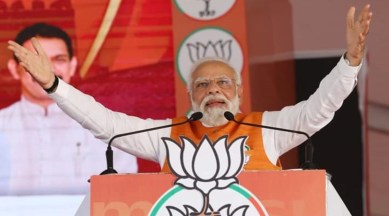Karnataka polls: All about Modi right till the end for BJP, mostly about local issues for Congress
With stakes high and the contest close, words were exchanged, and both sides filed several complaints with the Election Commission during the course of the campaign.

Congress president Mallikarjun Kharge made an emotional appeal, citing his age and an alleged threat to him by a BJP candidate, while the BJP’s retired hurt veteran B S Yediyurappa insisted the party would win a clear majority, as campaigning wrapped up for the bitterly contested Karnataka Assembly elections on Monday.
With stakes high and the contest close, words were exchanged, and both sides filed several complaints with the Election Commission during the course of the campaign.
Sensing victory after a long time in a major state – and the only one held by the BJP in the South – the Congress mounted an aggressive campaign, banking on its substantial organisational presence in the state, strong leaders such as Siddaramaiah and D K Shivakumar, and the appeal of the Gandhis. Apart from Rahul and Priyanka Gandhi Vadra, who spent extended time in Karnataka, even Sonia Gandhi pitched in, making a rare address at a rally.
From the BJP side, the bulk of the burden was borne by Prime Minister Narendra Modi, who in the last one week starting April 29, held 19 mega public meetings and six roadshows, with the poll slogan ‘Ee Baariya Nirdhara, Bahumatada BJP Sarkara (This Time’s Decision: Majority BJP Government)’.
It was he who turned around the Congress’s manifesto promise of action against outfits spreading hatred, such as the Bajrang Dal, into an attack on Lord Hanuman and his devotees. The BJP then took it up as its main campaign theme for the last leg.
Again, a day before the canvassing ended, Modi sensed a “secession” threat in a Congress tweet talking about “sovereignty” of Karnataka. On the last day Monday, it was this that dominated the poll discourse.
The BJP promised a “double-engine” government, and cited largely national issues and Central government programmes and schemes as its achievement. Before the elections were announced, Modi visited the state multiple times to unveil government schemes and projects.
On the last day, Yediyurappa sought to dispel the underlying fear in the BJP ranks that the Lingayats might vote against the party for sidelining him, the community’s old warhorse. He refuted claims that the Lingayats were moving away from the BJP, and said they would vote for the party come May 10, and that the BJP would get 130-135 seats.
On Sunday, a Lingayat forum wrote a public letter asking members of the community to back the Congress. Chief Minister Basavaraj Bommai, also a Lingayat, dismissed the group as a “fictional organisation”. As per the BJP, its national leaders held 206 public meetings and 90 roadshows while its state leaders held 231 meetings and 48 road shows.
The Congress largely managed to keep its campaign about local issues, its five “guarantees” to voters, and the BJP government’s corruption. When certain remarks by Kharge and his son and candidate Priyank against Modi threatened to derail this, the party quickly brought the campaign back on track. However, there is some nervousness in party ranks about its manifesto and its talk of a ban on the Bajrang Dal. Addressing a rally in Kalaburagi, his hometown, Monday, Kharge called himself the “bhoomi putra (son of the soil)” and said the polls were “an election for the future of Karnataka”. With much at stake for the 81-year-old, his first in his home state as the Congress president, Kharge accused the BJP of ignoring the region.
In a reference to an alleged assassination plot against him and his family by a BJP candidate, Kharge said he was 81, and “it might have come into the minds of BJP leaders to finish me off”, but that he would work for the poor till his last breath.
As per Congress count, its leaders held 99 public meetings and 33 road shows.
The JD(S), whose only hope is to be a kingmaker in a House of 224, also ran a highly localised campaign, promising a five-fold programme called ‘Pancharatna’, focused on education, health, housing and jobs.
While former CM H D Kumaraswamy shouldered the bulk of the campaign, the JD(S) also brought out its ailing supremo and former PM H D Deve Gowda to campaign for the party – and the family, given the number of members who have stakes in the state’s political pie.— With PTI inputs